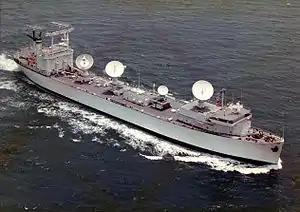Tracking ship
A tracking ship, also called a missile range instrumentation ship or range ship, is a ship equipped with antennas and electronics to support the launching and tracking of missiles and rockets. Since many missile ranges launch over ocean areas for safety reasons, range ships are used to extend the range of shore-based tracking facilities.




.png.webp)

In the United States, the initial tracking ships were constructed by the U.S. Army and then the U.S. Air Force to support their missile programs. They were generally built on a surplus Liberty ship or Victory ship hull. By 1964, the U.S. Navy took over all the range ships and introduced more.
In some Navies, such a ship is also given the Type Designation "Vigilship" or "Veladora"[1], with the Designation Letter "V" or Letters "VC".
Missile range instrumentation ships
Chinese PLA Strategic Support Force
The Chinese ships were purpose built vessels for their role in the navy and the space program.
- Yuanwang class
- Yuanwang 1, 1977 – present
- Yuanwang 2, 1978 – present
- Yuanwang 3, 1995 – present
- Yuanwang 4, 1999 – 2010
- Yuanwang 5, 2007 – present
- Yuanwang 6, 2007 – present
French Navy
The Poincaré was a converted tanker, but the Monge was a purpose built ship.
Inactive
Active
Indian Navy
Building
- DRDO Technology Demonstration Vessel - Under construction
- VC11184 Ocean Surveillance Ship - Undergoing sea trials
Russian Navy / Soviet Navy
The Soviet and later Russian ships were purpose built vessels for their role.
- Kosmonaut Vladimir Komarov, 1966–1989 (scrapped)
- Akademik Sergei Korolev, 1970–1996 (scrapped)
- Kosmonavt Yuri Gagarin, 1971–1996 (scrapped)
- Kosmonaut Viktor Patsaev, 1978–2001 (museum attraction)
- Kosmonaut Georgy Dobrovolsky, 1978–2006 (scrapped)
- Kosmonaut Pavel Belyaev, 1977–2000 (scrapped)
- Kosmonaut Vladislav Volkov, 1977–2000 (scrapped)
- Morzhovetz, 1967–1989 (scrapped)
- Nevel, 1967–1989 (scrapped)
- Borovitchi, 1967–1989 (scrapped)
- Kegostrov, 1967–1989 (scrapped)
- SSV-33 Ural, 1989–2001 (laid up, scrapping in progress)
- Marshal Nedelin, 1984–1996 (scrapped)
- Marshal Krylov, 1990
United States Navy/United States Air Force
There are currently only two active Instrumentation Ships in the U.S. Navy inventory: USNS Invincible (T-AGM-24)[4] and USNS Howard O. Lorenzen (T-AGM-25).[5] The latter was delivered in January 2012[6] to replace USNS Observation Island (T-AGM-23) in 2014.[7] Most of the USN and USAF tracking ships were converted into their role. Some ships were in service with NASA.
Inactive
- USNS Range Tracker (T-AGM-1), 1961–1969 - built as Victory ship (transport/freighter)
- USNS Range Recoverer (T-AGM-2), 1960–1972 - built for US Army
- USNS Longview (T-AGM-3), 1959–19? - built as Victory ship (transport/freighter)
- USNS Richfield (T-AGM-4), 1960–1968 - built as Victory ship (transport/freighter)
- USNS Sunnyvale (T-AGM-5), 1960–1974 - built as Victory ship (transport/freighter)
- USNS Watertown (T-AGM-6), 1960–1972 - built as Victory ship (transport/freighter)
- USNS Huntsville (T-AGM-7), 1960–1974 - built as Victory ship (transport/freighter)
- USNS Wheeling (T-AGM-8), 1962–1990 - built as Victory ship (transport/freighter)
- USNS General H. H. Arnold (T-AGM-9), 1961–1982 - built as C4 class troop ship
- USNS General Hoyt S. Vandenberg (T-AGM-10), 1963–1983 - built as C4 class troop ship
- USNS Twin Falls (T-AGM-11), 1964–1972 - built as Victory ship (transport/freighter)
- USNS American Mariner (T-AGM-12), 1959–1966 - built as Liberty ship (transport/freighter), US Coast Guard training ship
- USNS Sword Knot (T-AGM-13), 1950s–1982 - C1-M cargo ship built for US Maritime Commission
- USNS Rose Knot (T-AGM-14), 1950s–1969 - C1-M cargo ship built for US Maritime Commission
- USNS Coastal Sentry (T-AGM-15), 1950s–1972 - C1-M cargo ship built for US Maritime Commission
- USNS Coastal Crusader (T-AGM-16), late 1950s–1976 - C1-M cargo ship built for US Maritime Commission
- USNS Timber Hitch (T-AGM-17), 1964–1969 - C1-M cargo ship built for US Maritime Commission
- USNS Sampan Hitch (T-AGM-18), 1964–1973 - C1-M cargo ship built for US Maritime Commission
- USNS Vanguard (T-AGM-19), 1964–1999 - built as Type T2-SE-A2 tanker
- USNS Redstone (T-AGM-20), 1964–1993 - built as Type T2-SE-A2 tanker
- USNS Mercury (T‑AGM‑21), 1964–1974? - built as Type T2-SE-A2 tanker
- USNS Range Sentinel (T-AGM-22), 1969–1974 - USN Haskell-class attack transport (Victory ship variation) Sherburne (APA-205)
- USNS Observation Island (T-AGM-23), 1977–2014 - built as "Mariner" class merchant ship
Active
- USNS Waters (T-AGS-45), 1991–present
- USNS Invincible (T-AGM-24), 2000–present - built as ocean surveillance ship
- USNS Howard O. Lorenzen (T-AGM-25), 2012-present - purpose built to replace Observation Island.
- Pathfinder-class survey ships (T-AGS 60-66)
See also
| Wikimedia Commons has media related to Tracking ships. |
References
- Soviet ship Kosmonavt Yuriy Gagarin
- military-today.com, Poincare
- military-today.com, Monge
- "Military Sealift Command Fact Sheet". Retrieved 2008-02-10.
- "Range Instrumentation Ship Photo Index". Retrieved 2009-04-04.
- "Navy Accepts Delivery of USNS Howard O. Lorenzen". Navy.mil. 12 January 2012. No. NNS120112-16. Retrieved 2 February 2012.
- "SIU - Keel laid for future USNS Observation Island replacement (8/25)". Retrieved 2009-04-04.
